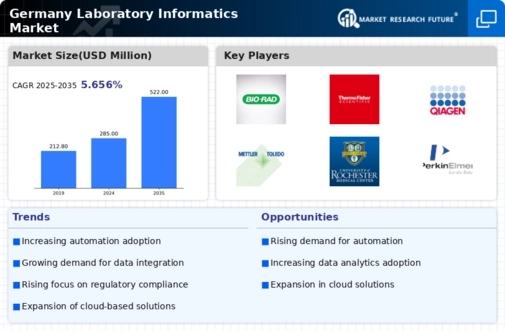Emergence of Personalized Medicine
The shift towards personalized medicine in Germany is significantly impacting the laboratory informatics market. As healthcare providers increasingly adopt tailored treatment approaches, laboratories are required to manage and analyze vast amounts of patient data efficiently. Informatics solutions that support genomic data analysis, biomarker identification, and patient stratification are becoming essential. This trend is expected to drive the laboratory informatics market, with a projected growth rate of 9% as laboratories seek to implement systems that can handle the complexities of personalized medicine. The integration of informatics in this context is likely to enhance patient outcomes and streamline laboratory operations.
Investment in Research and Development
Germany's commitment to innovation and research is fostering growth in the laboratory informatics market. Increased funding for research and development initiatives, particularly in life sciences and healthcare, is driving the demand for advanced informatics solutions. Laboratories are investing in informatics systems that support research activities, data management, and collaboration among researchers. This investment is expected to contribute to a robust growth trajectory for the laboratory informatics market, with projections indicating a potential increase of 15% in market size over the next five years. As research institutions seek to enhance their capabilities, the demand for laboratory informatics solutions is likely to rise.
Regulatory Compliance and Quality Assurance
In Germany, stringent regulatory requirements in the pharmaceutical and biotechnology sectors are significantly influencing the laboratory informatics market. Laboratories are increasingly adopting informatics solutions to ensure compliance with regulations such as Good Laboratory Practice (GLP) and Good Manufacturing Practice (GMP). These solutions facilitate data integrity, traceability, and reporting, which are essential for meeting regulatory standards. The market for compliance-driven informatics solutions is expected to expand at an estimated growth rate of 8% annually. As laboratories prioritize quality assurance and regulatory adherence, the laboratory informatics market is likely to see a surge in demand for specialized software and systems.
Growing Focus on Data Analytics and Insights
The laboratory informatics market in Germany is witnessing a growing emphasis on data analytics, as organizations seek to derive actionable insights from their laboratory data. Advanced analytics tools are being integrated into laboratory informatics systems, enabling scientists to make data-driven decisions and enhance research outcomes. The increasing volume of data generated in laboratories necessitates robust analytics capabilities, which are projected to grow at a rate of 12% over the next few years. This trend indicates a shift towards more sophisticated informatics solutions that can handle complex data sets, thereby driving the laboratory informatics market's expansion.
Rising Demand for Automation in Laboratories
The laboratory informatics market in Germany is experiencing a notable shift towards automation. This shift is driven by the need for increased efficiency and accuracy in laboratory processes. Automation technologies, such as robotic systems and automated data management solutions, are being integrated into laboratory workflows. This trend is expected to enhance productivity, reduce human error, and streamline operations. According to recent data, the automation segment is projected to grow at a CAGR of approximately 10% over the next five years. As laboratories seek to optimize their operations, the demand for sophisticated informatics solutions that support automation is likely to rise, thereby propelling the laboratory informatics market forward.




















Leave a Comment